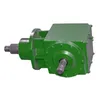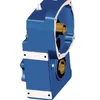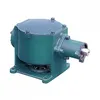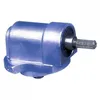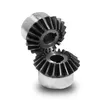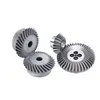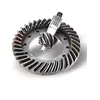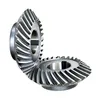Bevel gears are a type of gear mechanism used to transmit power between intersecting axes, typically at a 90-degree angle. They are essential components in various machinery, from automotive differentials to industrial equipment, offering efficient torque transfer and motion control. With advancements in manufacturing, bevel gears are now available in a range of materials and configurations to suit diverse applications.
When selecting or designing bevel gears, it is crucial to consider several parameters to ensure optimal performance. Below is a detailed list and table outlining the key specifications.
| Parameter | Standard Values | Units | Application Notes |
|---|---|---|---|
| Module Range | 1 to 10 | mm | Smaller modules for precision, larger for heavy-duty use. |
| Number of Teeth | 10 to 100 | - | Customizable based on gear ratio requirements. |
| Pressure Angle | 20° (common), 14.5° | Degrees | 20° offers higher strength; 14.5° for smoother operation. |
| Material Options | Steel (e.g., AISI 1045), Cast Iron, Brass, Nylon | - | Steel for high load, nylon for quiet, low-load applications. |
| Hardness (for Steel) | 45-60 HRC | HRC | Higher hardness increases wear resistance. |
| Face Width | 10-50 | mm | Wider face for higher torque transmission. |
| Accuracy Grade (ISO) | 5 to 12 | - | Grade 5 for high precision, Grade 12 for general use. |
Bevel gears are widely used across industries due to their versatility. In automotive systems, they are integral to differentials, enabling wheels to rotate at different speeds. In industrial machinery, they facilitate power transmission in conveyor systems, milling machines, and robotics. Additionally, they are found in marine applications, aerospace systems, and even household appliances like drills and mixers, where directional power change is required.
Here are some common questions and detailed answers to help you understand bevel gears better.
What is the primary function of a bevel gear?
The primary function of a bevel gear is to change the direction of power transmission between two intersecting shafts, usually at a 90-degree angle, while maintaining or altering speed and torque levels based on the gear ratio.
How do I choose the right material for a bevel gear?
Select the material based on the application requirements: use steel for high-strength and durability in heavy-load scenarios, cast iron for cost-effectiveness and good wear resistance, brass for corrosion resistance in marine environments, and plastic or nylon for lightweight, low-noise operations in consumer products.
What maintenance is required for bevel gears?
Regular maintenance includes lubrication to reduce friction and prevent wear, inspection for tooth damage or misalignment, and cleaning to remove debris. The frequency depends on usage intensity; for high-speed applications, checks should be performed more frequently, such as every 500 hours of operation.
Can bevel gears be used for non-90-degree angles?
Yes, bevel gears can be designed for angles other than 90 degrees, such as 45 degrees or 120 degrees, but 90 degrees is the most common. Custom angles require precise manufacturing to ensure proper meshing and efficiency.
What are the common types of bevel gears?
Common types include straight bevel gears, which have straight teeth and are easy to manufacture; spiral bevel gears, with curved teeth for smoother and quieter operation; and hypoid bevel gears, which allow for non-intersecting axes and are used in automotive differentials for higher torque capacity.
How does the number of teeth affect bevel gear performance?
The number of teeth determines the gear ratio (ratio of teeth between driven and driver gears), which affects speed and torque. A higher number of teeth on the driven gear increases torque but reduces speed, while fewer teeth can increase speed but decrease torque, so it must be balanced for the application.
What are the signs of bevel gear failure?
Signs include unusual noise during operation, vibration, overheating due to poor lubrication, visible wear or pitting on tooth surfaces, and decreased efficiency in power transmission. Early detection through routine inspections can prevent catastrophic failures.
Are bevel gears customizable?
Yes, bevel gears can be customized in terms of size, material, number of teeth, pressure angle, and accuracy grade to meet specific application needs. Customization often involves working with manufacturers to design gears based on detailed specifications and testing protocols.
